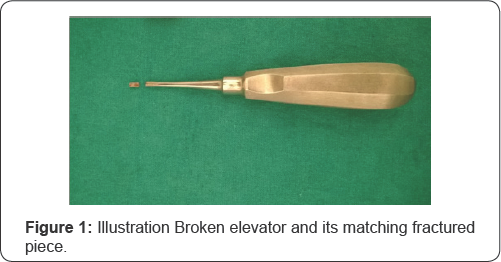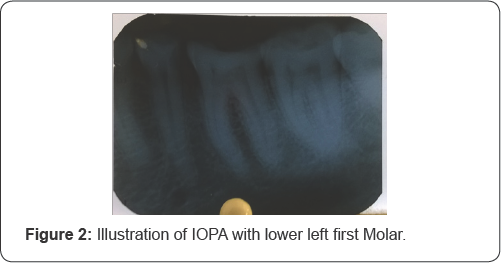An Unusual Accident during a Molar Extraction: A Rare Case Report Breakage of Surgical Instrument an Uncommon Intra-Operative Complication-Juniper publishers
JUNIPER PUBLISHERS-OPEN ACCESS JOURNAL OF HEAD NECK & SPINE SURGERY
Abstract
Background: Fracture of Surgical Instruments
is an unusual intraoperative complication. Inappropriate handling of a
surgical instrument or poor tools may lead to breakage of the
instrument. This article presents a case of a dental elevator fracture
during extraction of mandibular molar.
Case report: A 35 year-old male patient
reported to the Department of Oral & Maxillofacial Surgery at
Swargiya Dadasaheb Kalmegh Smruti Dental College & Hospital, Nagpur
with chief complaint of pain in lower left back region of jaw since 1
month. But, it was observed that the dental elevator tip had broken
during extraction by operator. The metallic fragment was removed to
assure it completed the whole missing part of elevator.
Conclusion: All dental professionals should
pay careful attention to the instruments used during dental procedures,
especially the surgical ones. It is always advisable to afford reliable
trademarks and products with quality control. Always, check the
integrity of the instrument before and after the surgical procedure. If
an incidence happens, dentists should take proper measures to solve the
problem without further injury to the patient. If an unexpected
incidence occurs, the patient must be informed and to manage the
surgical complications.
Keywords: Instrument breakage; Elevator tipIntroduction
Accident can occurs from an operator technique intra-
operatively due to number of factors including operator technique error
and quality of surgical instruments. Manufacturer should follow the
optimum standards, particularly in the case of dental, medical and
surgical instruments which could cause serious injuries to patients.
Despites adequate effort to perform tooth removal carefully, some
mishaps may happen when substandard instruments are unknowingly used [1].
Dental elevator is an instrument used in minor oral
surgical procedures to elevate the tooth or root from its socket. In
literature, breakage of surgical instruments is an unusual
intraoperative complication as compared to broken endodontic
instruments.
Dental and Oral Surgeons should be particularly
careful when metal instruments deployed with strong force are used in
poorly visible area. If an unsuspected accident take place during
surgical procedure the patient should be informed in accordance with
ethical code, and suitable measures implemented to resolve the problem.
Aim of the present article is to report a case of fracture of a dental elevator tip during the extraction of mandibular molar.
Case Description 1
A 70 year-old male patient reported to the Department
of Oral & Maxillofacial Surgery at Swargiya Dadasaheb Kalmegh
Smruti Dental College & Hospital, Nagpur with chief complaint of
missing teeth in lower left back region of jaw and wants to replace it.
Clinical picture shows blackish discoloration in regions of lower left
first molar region. After all required radiographic investigations, a
well-defined radiopaque foreign body was detected in region of
mandibular second molar region. Patient was operated under local
anesthesia. Crestal incision was given in edentulous region of 46 and
releasing incision was given on mucobuccal line angle of 47.
Muco-periosteal flap was raised exposing the healed socket. The foreign
body along with surrounding blackish discoloration was retrieved
followed by curettage (Figure 1).
The foreign body was found to be a tip of a Pencile. Smoothening of
bony margin followed by thorough irrigation was carried out with
betadine and normal saline. Flap was repositioned and sutured with 3-0
silk. Patient was kept for follow up and sutures were removed on 7th day
postoperatively. The healing was uneventful and painless.

Case Description 2

A 35 year-old male patient reported to the Department
of Oral & Maxillofacial Surgery at Swargiya Dadasaheb Kalmegh
Smruti Dental College & Hospital, Nagpur with chief complaint of
pain in lower left back region of jaw since 1 month. The tooth was firm
with long roots (Figure 2).
Extraction was carried out with the help of dental elevator (Coupland
type). Surprisingly, the elevator's broken edge point was lodged in the
mesial part of the first molar from where the elevator was applied.
However, it was observed that the dental elevator tip had broken during
extraction. The metallic fragment was removed to assure it completed the
whole missing part of elevator (Figure 1 & 3). However, extraction was perform with routine dental forceps. Suture and postoperative medication were giving.

Discussion
In the literature, only three papers were found about broken surgical instruments during extraction procedures [2,3].
One of them reported three cases of broken new extraction elevators,
which were found to be defective. The instruments were broken during
routine use on three different patients on the same day and the
fragments were found in the aspiration bottles, and were retrieved
making unnecessary to radiate the patient to locate the fragment [2]. According to Whitehouse [4]
reported two cases of broken dental forceps, where a broken fragment
was rescued from the patient's mouth uneventfully, and in the other, the
hinge pin came out of the forceps and was swallowed by the patient. The
last paper reported the retrieval of an elevator's end that broke
during the extraction of a lower right third molar, and was found with
the aid of a metal detector (Keeler metal detector - Goring Keeler Ltd.,
England)[3].
Moore [4]
proved that the use of a metal detector was effective to pinpoint the
metal presence in a surgical area. When placed near metal, the detector
probe measures the change in the inductance, emitting different tones,
thus locating the foreign body. The detector can also distinguish
between different metals (steel, brass, aluminum, lead) emitting
different signals, which can prove to be useful in a clinical situation.
In spite of all the difficulties that could arise
during a broken fragment removal, it is always practical to try to
remove the fragment in order to prevent it from migrating into a
neighboring space. Even if metallic fragments could be enclosed in a
fibrous tissue capsule when recognized by the organism as a foreign
body, objects dislodged into the soft tissues on the lingual side of the
mandible may gain access to the submandibular and parapharyngeal spaces
[4].
According to Altan et al. [5]
present three unusual cases of forgein body in the oral cavity In first
case elevator was broken during impacted third molar surgery and it was
missed out into the tissue. Second case Broken round bur piece was seen
in the impacted third molar region. Third case broken drill bur was
found in the mandibular fracture as a forgein body which were removed
successfully [5].
On the other hand, a single intraoral periapical
radiograph (IOPA) or tube-shift technique may be sufficient. In
addition, occlusal radiography can also be employed as necessary. If an
occlusal film is not available an intraoral periapical radiograph can be
put on occlusally, or on the edentulous crest, and this may reveal an
embedded foreign object. Cone beam computerized tomography (CBCT) is an
excellent tool to locate metallic foreign objects. It can be used to
locate the exact position of foreign body if inaccessible according to
routine radiograph techniques [6].
Surgical instrument manufactures should carry out
strict quality controls and have their instruments bear a visible mark
as a sign of guarantee. Various authors have suggested that the inferior
quality of some surgical instruments may be a reflection of poor
working conditions and low standards tools, principally in the
developing world. Responsibility lies with the suppliers from developed
countries manufacturing in the developing world who behave in an
unethical manner, maximizing profits and minimizing the compensation of
the people who actually produce the goods [7,8].
A safe and effective elevator should have extreme
values for torque and stress values. Metal instruments used in clinical
practise may be subjected to fatigue from sterilization. Standard
Autoclave machine should be used for autoclaving and instruments should
be kept dry to avoid corrosion, which ultimately weakens the instrument
to avoid corrosion [9] (Table 1 & 2).


Conclusion
All Dental specialists should always pay careful
attention to the instruments used during dental procedures, especially
the surgical ones. It is always advisable to afford reliable trademarks
and products with quality control. It is duty of dentist to check the
surgical instrument for any sign of breakage before and after the
surgical procedure. If an untoward accident happens, dentists should
take the proper measures to solve the issue without further injury to
the patient.
Accidents like the one described in this report have
dentist's responsibility because accidents may result in litigation
although it is impossible for dentists to prevent them from happening.
In the present case report, although the accident may be attributed to a
defective instrument, the patient has the right to prosecute the
professional. Despite being a particular situation, it should be
stressed out that accidents like the one here described should be dealt
according to the different laws adopted by different countries.
To know more about Open Access Journal of
Head Neck & Spine Surgery please click on:
To know more about Open access Journals
Publishers please click on : Juniper Publishers
Comments
Post a Comment